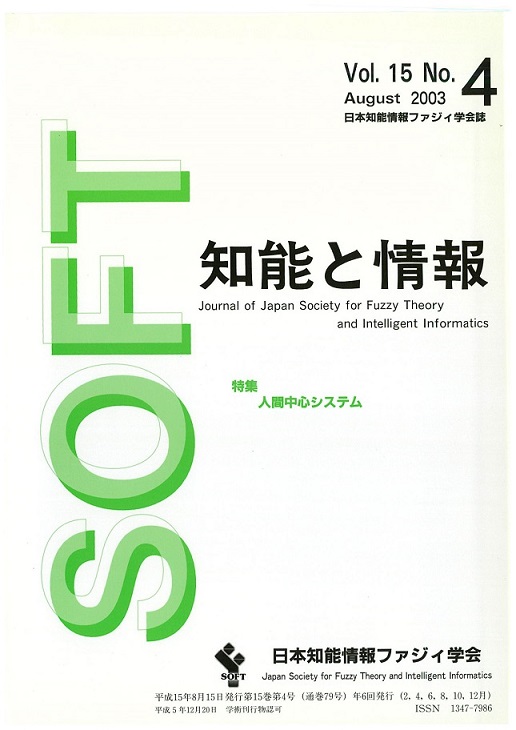Volume 15, Issue 4
Displaying 1-26 of 26 articles from this issue
- |<
- <
- 1
- >
- >|
-
Article type: Index
2003Volume 15Issue 4 Pages Toc4-
Published: August 15, 2003
Released on J-STAGE: December 19, 2017
Download PDF (63K)
-
Article type: Article
2003Volume 15Issue 4 Pages 363-
Published: August 15, 2003
Released on J-STAGE: May 29, 2017
Download PDF (200K)
-
Article type: Article
2003Volume 15Issue 4 Pages 364-365
Published: August 15, 2003
Released on J-STAGE: May 29, 2017
Download PDF (227K) -
Article type: Article
2003Volume 15Issue 4 Pages 366-371
Published: August 15, 2003
Released on J-STAGE: May 29, 2017
Download PDF (1209K) -
Article type: Article
2003Volume 15Issue 4 Pages 372-378
Published: August 15, 2003
Released on J-STAGE: May 29, 2017
Download PDF (996K) -
Article type: Article
2003Volume 15Issue 4 Pages 379-390
Published: August 15, 2003
Released on J-STAGE: May 29, 2017
Download PDF (1721K) -
Article type: Article
2003Volume 15Issue 4 Pages 391-400
Published: August 15, 2003
Released on J-STAGE: May 29, 2017
Download PDF (1707K)
-
Article type: Article
2003Volume 15Issue 4 Pages 401-
Published: August 15, 2003
Released on J-STAGE: May 29, 2017
Download PDF (296K)
-
Article type: Article
2003Volume 15Issue 4 Pages 402-
Published: August 15, 2003
Released on J-STAGE: May 29, 2017
Download PDF (198K)
-
Article type: Article
2003Volume 15Issue 4 Pages 403-
Published: August 15, 2003
Released on J-STAGE: May 29, 2017
Download PDF (198K) -
Article type: Article
2003Volume 15Issue 4 Pages 403-
Published: August 15, 2003
Released on J-STAGE: May 29, 2017
Download PDF (198K)
-
Article type: Article
2003Volume 15Issue 4 Pages 404-
Published: August 15, 2003
Released on J-STAGE: May 29, 2017
Download PDF (226K)
-
Article type: Article
2003Volume 15Issue 4 Pages 405-
Published: August 15, 2003
Released on J-STAGE: May 29, 2017
Download PDF (167K) -
Article type: Article
2003Volume 15Issue 4 Pages 405-
Published: August 15, 2003
Released on J-STAGE: May 29, 2017
Download PDF (167K)
-
Article type: Article
2003Volume 15Issue 4 Pages 406-407
Published: August 15, 2003
Released on J-STAGE: May 29, 2017
Download PDF (331K)
Regular
Original Papers
-
Article type: Article
2003Volume 15Issue 4 Pages 408-420
Published: August 15, 2003
Released on J-STAGE: May 29, 2017
Download PDF (1080K) -
Article type: Article
2003Volume 15Issue 4 Pages 421-428
Published: August 15, 2003
Released on J-STAGE: May 29, 2017
Download PDF (864K) -
Article type: Article
2003Volume 15Issue 4 Pages 429-439
Published: August 15, 2003
Released on J-STAGE: May 29, 2017
Download PDF (1325K) -
Article type: Article
2003Volume 15Issue 4 Pages 440-451
Published: August 15, 2003
Released on J-STAGE: May 29, 2017
Download PDF (2002K) -
Article type: Article
2003Volume 15Issue 4 Pages 452-464
Published: August 15, 2003
Released on J-STAGE: May 29, 2017
Download PDF (1113K)
Short Notes
-
Article type: Article
2003Volume 15Issue 4 Pages 465-474
Published: August 15, 2003
Released on J-STAGE: May 29, 2017
Download PDF (1126K)
-
Article type: Appendix
2003Volume 15Issue 4 Pages 475-
Published: August 15, 2003
Released on J-STAGE: May 29, 2017
Download PDF (24K) -
Article type: Article
2003Volume 15Issue 4 Pages 476-
Published: August 15, 2003
Released on J-STAGE: May 29, 2017
Download PDF (158K) -
Article type: Article
2003Volume 15Issue 4 Pages 477-
Published: August 15, 2003
Released on J-STAGE: May 29, 2017
Download PDF (155K) -
Article type: Appendix
2003Volume 15Issue 4 Pages 478-
Published: August 15, 2003
Released on J-STAGE: May 29, 2017
Download PDF (60K)
-
Article type: Appendix
2003Volume 15Issue 4 Pages A1-A5
Published: August 15, 2003
Released on J-STAGE: May 29, 2017
Download PDF (254K)
- |<
- <
- 1
- >
- >|
